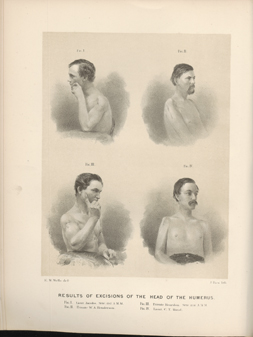Title: Jacobs, Horace G.
Source text: The Medical and Surgical History of the War of the Rebellion. (1861-65.), Part 2, Volume 2 (Washington, DC: Government Printing Office, 1876), 553.
Civil War Washington ID: med.d2e31165
TEI/XML: med.d2e31165.xml
CASE 1533.—Lieutenant Horace G. Jacobs, Co. G, 6th Maine, aged 18 years, was wounded at Rappahannock Station, November 7, 1863, by a conoidal ball, which entered the left shoulder posteriorly, two inches from the acromion process, fractured the upper extremity of the humerus, and made its exit an inch and a half below the middle of the clavicle. He was sent to Washington, and received at Armory Square Hospital. Surgeon D. W. Bliss, U. S. V., reported: "A ball, supposed to be conoidal. entered posteriorly two inches from the acromion process, passing through the head of the humerus, fracturing off the upper two-thirds of the head of the bone comminuting the inner portions and about two inches of the shall of the humerus. Exit one and a half inches below the clavicle, at the middle third. November 10th, head of the humerus and about two inches of the shaft exsected; the S-incision made through the soft parts; ordinary hæmorrhage; patient under chloroform. No vessels required ligation. The patient came out of the anæsthetic well. At the time of operation, the parts were swollen and ecchymosed; his constitutional condition was good, but he was somewhat feverish. The patient made a good recovery." The operator transmitted the pathological specimen (FIG. 430) to the Army Medical Museum. This officer was furloughed January 12, 1864, and, returning to Washington, was treated in quarters, by Surgeon T. Antisell, U. S. V. On May 28, 1864, the wound had healed, and Lieutenant Jacobs was discharged from service (S. O. 190, A. G. O.), and pensioned. Examiner A. G. Peabody, of Machias, Maine, reported substantially the facts already detailed regarding the injury and operation. Mr. Jacobs was subsequently employed in the office of the Commissary General of Subsistence. In January, 1866, he called at the Museum, and a photograph was taken of the injured shoulder. It is represented by the first figure in PLATE XIV, opposite page 529. At that time his control over the mutilated arm was more complete than in any other case of excision of the upper extremity of the humerus for shot injury that had come under observation at the Museum. He could put his hand on the top of his head and could lift a heavy weight. The amount of shortening was precisely three inches. The favorable result thus happily achieved was lasting; for, in January, 1875, Mr. Jacobs could use his arm even better than ten years before, and was on duty in the Treasury Department. His general health was excellent, and his control over the movements of the left arm was so perfect, that by any but a close professional observer the mutilation he had undergone would be unnoticed.
FIG. 430.—Excised upper extremity of the left humerus, shattered by a musket ball. Spec. 1767.
